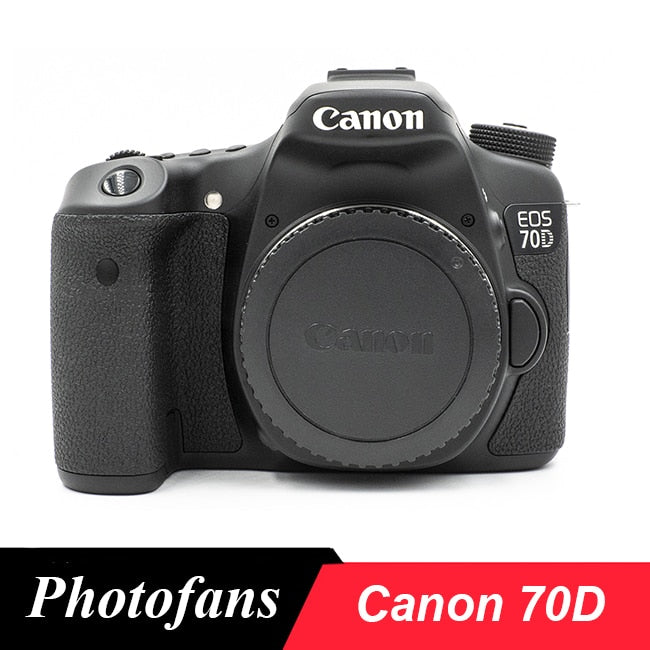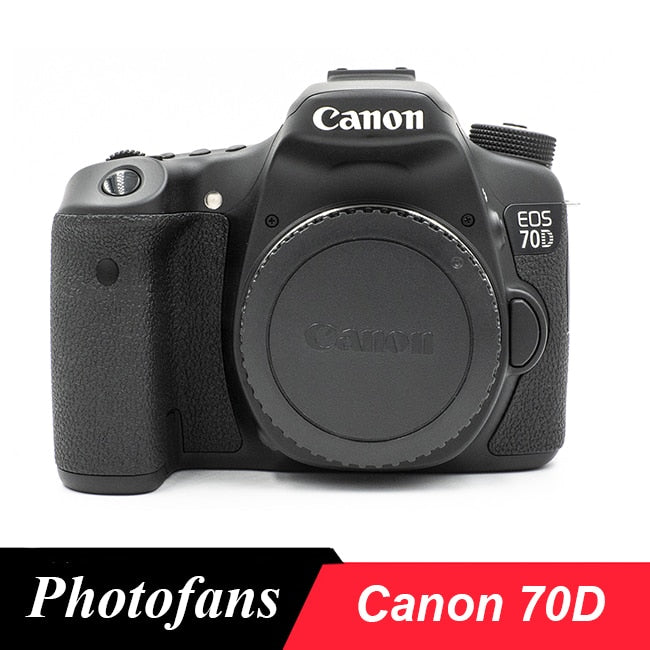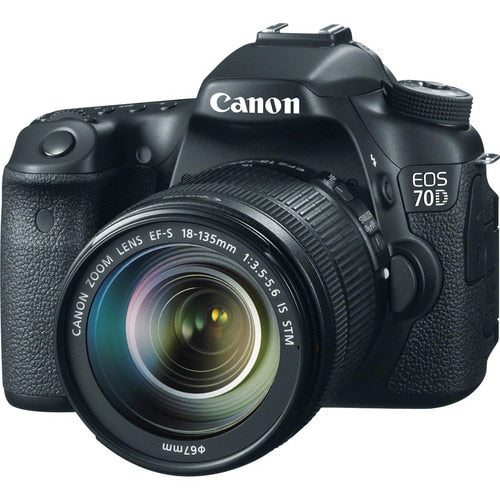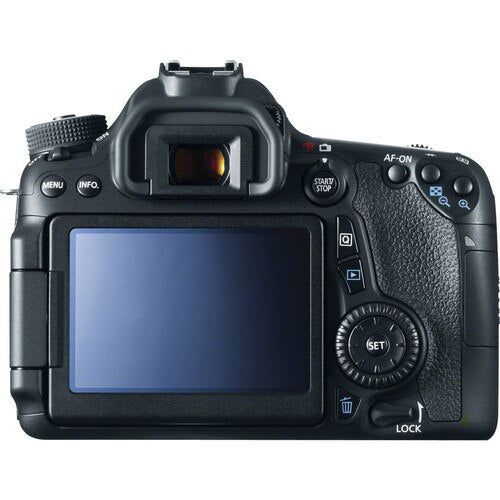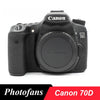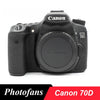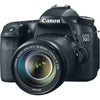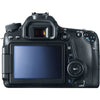Canon 70D DSLR Camera -Vari-Angle Touchscreen -Video -Wi-Fi
- Product SKU: 200007763:201336100;200000828:201589807#Body without lens
- Category: cameras & cannon, Glolo basis collection

- Order within
SPECIFICATIONS
Brand Name: CANON
Origin: JP(Origin)
Effective MegaPixel: 20MP
Set Type: Zoom Sets
Special Feature: Swivel/Tilt LCD
Special Feature: Touch Screen
Special Feature: WiFi
Certification: CE
Video Resolution: Full HD (1920x1080)
Sensor Size (inches): APS-C
Still Images File Formats: JPEG, RAW
ISO Sensitivity: 100-12800 (Extended Mode: 100-25600)
Model Number: 70D
Memory Card Type: SD Card
Audio File Formats: Linear PCM (Stereo)
Weight: 755 g with battery and memory card
Size: 139.0 x 104.3 x 78.5 mm
Movies File Formats: MOV, MPEG-4 AVC/H.264
Sensor Type / Size: CMOS, 22.5 x 15 mm
Autofocus Points: 19
Viewfinder Coverage: 98%
Display Screen: 3" Rear Touchscreen Swivel LCD (1,040,000)
Wi-Fi Capable: Yes
Canon 70D DSLR Camera (Brand New)
Product Highlights
- 20.2MP APS-C CMOS Sensor
- DIGIC 5+ Image Processor
- 3.0" 1.04m-Dot Vari-Angle Touchscreen
- Full HD 1080p/30 Video & Movie Servo AF
- Dual Pixel CMOS AF with Live View
- 19-Point All Cross-Type Phase-Detect AF
- Native ISO 12800, Extended to ISO 25600
- 7 fps Shooting at Full Resolution
- Built-In Wi-Fi Connectivity
- 63-Zone Dual Layer Metering Sensor
The Canon 70D DSLR Camera features a 20.2 megapixel APS-C CMOS sensor and DIGIC 5+ image processor to ensure high-resolution images and excellent low-light sensitivity. Both the sensor and processor work together to produce well-detailed, clear imagery that exhibits natural tonality and color gradations with minimal noise when working in difficult lighting conditions. The processor also provides notable speed throughout the camera system, including the ability to record up to 7 fps in full-resolution, quickened AF speeds, and full HD 1080p video recording in multiple frame rates with manual exposure and audio level control.

Serving to benefit working with live view in both still and movie shooting modes, Dual Pixel CMOS AF is a powerful technology that revolves around the incorporation of two photodiodes within each pixel to provide an expansive phase-detection focusing system. This system affords focusing advantages that are similar to how a camcorder works and as such can focus on subjects in an incredibly fast and precise manner. The benefits of this system are three-fold: the ability to focus quickly and smoothly; the ability to truly utilize the vari-angle touchscreen LCD monitor to its full potential; and the ability to utilize a wide range of over 100 EF and EF-S lenses. Also benefiting from Dual Pixel CMOS AF is the Movie Servo AF mode, which enables continuous auto focusing when recording movies. This focusing mode is especially useful for maintaining critical focus on moving subjects and for realizing the near-silent performance of compatible STM lenses.
The 3.0" 1,040k-dot vari-angle Clear View II touchscreen LCD monitor profits greatly from the advent of the Dual Pixel CMOS AF system and its ability to utilize Touch AF focusing for finely controlled selection of the point of focus. The monitor's vari-angle design also enables more efficient shooting and viewing from both high and low angles and an anti-reflective, smudge-resistant coating allows for clear well-detailed viewing.
In addition to the LCD monitor, the 70D also features an optical pentaprism finder that can be used for eye-level shooting of still images. This Intelligent Viewfinder incorporates a superimposed LCD to provide an intuitive means for monitoring exposure and camera settings during shooting. While working with the viewfinder, an expansive 19-point all cross-type AF system is visualized for acquiring focus; integral to this array is a high-precision dual-cross center AF point that is compatible with f/2.8 and faster lenses.
Providing a wealth of additional functionality to the camera is integrated Wi-Fi connectivity, which allows instant and direct sharing of image files to an iOS or Android mobile device for sharing online. This functionality also allows for wireless remote control over camera settings, including exposure controls, focusing, and shutter release, from a mobile device when using the Canon Remote app.
- Dual Pixel CMOS AF
- Dual Pixel CMOS AF is a refined live view focusing technology that works to provide incredibly quick and precise auto focusing abilities that function in a similar manner to how a camcorder acquires focus. This system integrates two separate photodiodes within each pixel to provide a broad and dense network of phase-detection gathering elements to help reduce focus hunting for faster, more direct control of focus placement. Dual Pixel CMOS AF is utilized during live view applications, for either still or video shooting, and enables an enhanced method of working with the vari-angle touchscreen LCD monitor.
-
When working with still imagery, this focusing system works to acquire focus quickly and accurately, making it ideally suited to shooting and tracking moving subjects so that critical focus is attained with each shot. When shooting video, focusing is smooth and natural when changing from different subjects or different distances within the scene. Benefited by the Touch AF system, rack focus is possible simply by touching elements within the scene on the touchscreen in order to change focus in an intuitive manner. Subject tracking in movies is also heightened due to the Dual Pixel CMOS AF system's ability to recognize subjects and maintain focus when working within changing or cluttered scenery. -
This focusing system provides full and intuitive use of the vari-angle touchscreen monitor through its keen integration of touch controls for focusing and articulating design of the screen for viewing from any shooting angle. Additionally, Dual Pixel CMOS AF is fully supported by over 100 current and former EF and EF-S lenses to offer a wide spectrum of compatibility for both still and video applications.
- 20.2MP CMOS Sensor and DIGIC 5+ Image Processor
- In regard to imaging capabilities, the Canon 70D features a 20.2 megapixel APS-C CMOS sensor and DIGIC 5+ image processor to produce high-resolution, well-detailed still imagery and full HD 1080p video with notable low-light sensitivity. These two technologies work together to enable 14-bit A/D conversion, which helps to improve the quality and gradation of imagery by producing smoother, more natural-looking results with minimal image noise. A native ISO sensitivity of 100-12800 is well-suited to working in difficult lighting conditions and the processing power of the DIGIC 5+ processor also affords a wealth of speed to all aspects of the camera, including a full-resolution continuous shooting rate of 7 fps.
- Built-In Wireless Connectivity
- Integrated Wi-Fi provides remote control over the camera's exposure settings (aperture, shutter speed, and ISO) as well as focus and the shutter release from an iOS or Android mobile device when using the Canon Remote app. With this app, you can wirelessly control the 70D from a distance and utilize live view monitoring from your mobile device for easier shooting from difficult angles and locations. Images from the 70D can be backed-up to other wireless-enabled Canon cameras as well as networked PCs and mobile devices for instant sharing via email or to social networking and image hosting sites. Full DLNA (Digital Living Network Alliance) compatibility also enables transferring of files to other DLNA-compatible products like HDTVs and other wireless devices for remote viewing and playback. When working from the camera alone, files can also be transferred directly to the CANON iMAGE GATE WAY for expedited sharing to social networking sites without the need of a PC. PictBridge compatibility is also available and offers support for wirelessly printing photos from the camera on a PictBridge-compatible printer.
-
When used in combination with the optional GP-E2 GPS Receiver, geotagging and embedding of locational data into images' metadata is possible for plotting imagery to maps and for recording the elevation, direction, and Universal Coordinated Time (UTC) of each photograph.
- Canon HD Video
- Full HD 1080p video recording is supported at 30, 24, and 25 fps as well as HD and SD video recording in multiple frame rates. Video is recorded using the high quality H.264/MPEG-4 AVC codec and manual exposure control is supported for greater refinement over the look and feel of recordings. Video clips are automatically partitioned after the file size has reached 4GB and both IPB and All i-frame compressions are available for use depending on editing and output preferences. Sound can be recorded using the built-in stereo microphone, or with an optional external microphone using the 3.5mm microphone terminal, and controlled manually across 64 levels. An attenuator function is also employed to prevent audio clipping for cleaner overall sound.
-
Movie Servo AF mode is available to provide continuous auto focusing when recording video and pairs especially well when using an STM lens to realize near-silent focusing during filming. Focusing is also heavily benefitted by the incorporation of the Dual Pixel CMOS AF system to provide smooth, controllable focusing in live view with the added benefit of the Touch AF function. -
The Video Snapshot mode can also be used to record short video clips, in 2, 4, or 8-second segments, and in-camera editing and music can be applied to these files for finalized results straight from the camera.
- 3.0" Clear View II LCD Monitor and Intelligent Viewfinder
- A large, bright 3.0" 1,040k-dot vari-angle Clear View II touchscreen LCD monitor is integrated into the 70D to enable clear live view monitoring, image playback, and intuitive menu navigation. It's vari-angle design aids in viewing from high and low angles and the touchscreen control gives way to efficient navigation of menus and shooting controls, as well as precise control over focus points. The screen's construction incorporates an anti-reflective, smudge-resistant coating to provide clearer viewing, even in bright, sunlit conditions.
-
When working with still imagery and shooting at eye-level, an optical pentaprism Intelligent Viewfinder is available and provides 98% frame coverage. A superimposed LCD screen within the viewfinder provides pertinent exposure and camera information for more efficient eye-level shooting and also has the ability to outline AF points, grid lines, and an electronic level to aid in composition.
- 19-Point All Cross-Type AF System
- When shooting with the optical viewfinder, a 19-point all cross-type autofocus system is used to provide a wide range of focusing coverage for acquiring focus accurately and quickly. The center point of this cluster is a high-precision dual cross-type sensor that supports focusing with f/2.8 and faster lenses in order to benefit focusing in low-light conditions. These focus points are configurable and allow homing in on specific elements within the frame to focus on, or, alternatively, all can be used to provide coverage across the frame.
- iFCL 63-Zone Dual Layer Metering Sensor
- An intelligent metering system works in conjunction with the autofocus system and independently analyzes focus, color, and luminance within the scene for the most precise exposure settings possible. The 63 zones cover the entire image area with great detail and the dual-layer design permits a wider sensitivity to different wavelengths of light. The dual layers are split into a red/green channel and a blue/green channel; which counters the red light sensitivity bias electronic sensors inherently have. A series of algorithms are employed to combine data received from both layers, with the resulting exposure reading being extremely accurate regardless of the shooting conditions.
-
This metering system employs evaluative, center-weighted, and spot metering methods to determine exposure, as well as allowing for a +/- 5 EV exposure compensation for greater manipulation of the determined exposure setting.
- Built-In HDR and Multiple Exposure Modes
- A High Dynamic Range (HDR) mode is available and allows for the creation of HDR images in-camera, reducing the time needed to manually overlay images in post-production. When using this mode, a series of bracketed exposures are made of the same image, then automatically composited, resulting in a photograph with controlled highlights, detailed shadows, and a long middle range of tones. This mode is especially useful when photographing scenes with a great deal of contrast.
-
Multiple exposures are also possible in-camera and up to 9 exposures can be recorded onto a single file using 2 distinct settings for control. When in Additive mode, this closely resembles making multiple exposures on film and layers each exposure; manual exposure compensation is required. Average mode layers the images and automatically compensates for the final exposure, eliminating the unintended possibility of gross under or overexposure. Multiple exposures can be recorded in either JPEG or RAW formats, and furthermore you can utilize an existing RAW image as a starting point from which to layer subsequent images, which can then be manipulated in real time on the LCD.
- Scene Intelligent Auto and Special Scene Modes
- Scene Intelligent Auto mode incorporates a number of Canon's automatic exposure technology together in order to output a well-refined exposure. Picture Style Auto, Automatic Lighting Optimizer, Automatic White Balance, Autofocus, and Automatic Exposure are all employed to intelligently analyze the scene at hand and produce the most effective exposure settings to clearly render your subject matter.
-
Special Scene modes also help to enhance your imagery by applying a system of corrections for use in more difficult lighting situations. Handheld Night Scene automatically captures four consecutive exposures, at shutter speeds fast enough to handhold, and layers them into a single frame. This allows you to effectively record images in darker situations without the need of a tripod or stabilization device. HDR Backlight Control works in the same manner and records a series of exposures at different values to ensure highlight and shadow values are not lost. These under and over-exposed images are blended to create a final image with a wider dynamic range.
- Other Camera Features
-
- Multi Shot Noise Reduction automatically composites four sequential exposures together in order to gain one exposure that exhibits minimal apparent noise.
- Peripheral illumination, chromatic aberration, and distortion corrections are available and programmable through a menu of different available EF lenses. This lens data is used to automatically correct for each individual lens' traits to produce the cleanest image possible.
- Seven Filters are available to aesthetically modify the appearance of imagery in-camera, with the results visible in real time when working in live view. These filters include Grainy Black and White, Soft Focus, Fisheye Effect, Toy Camera Effect, Miniature Effect, Art Bold Effect, and Water Painting Effect.
- Compatible with SD, SDHC, and SDXC, including Ultra High Speed (UHS-I), memory cards.
- Compatible with eTTL II flash metering for use with compatible external flash units.
- A built-in pop-up flash is available to provide additional illumination to scenes.
- Silent shooting is a low-vibration shooting mode that slows and mutes the shutter and mirror reflex, enabling a more discrete method of capturing imagery.
- In-camera RAW processing allows for the converting of RAW image files to JPEGs without the need for a computer. When using this function, 10 process variables-brightness adjustment, white balance, Picture Style, Auto Lighting Optimizer, noise reduction, JPEG image-recording quality, color space, lens peripheral illumination correction, distortion correction, and chromatic aberration correction-are available for fine-tuning the appearance of photos.
- A Feature Guide can be employed to help explain and the specific functions of each dedicated camera control to help for properly applying a variety of settings while shooting.




SPECIFICATIONS
Brand Name: CANON
Origin: JP(Origin)
Effective MegaPixel: 20MP
Set Type: Zoom Sets
Special Feature: Swivel/Tilt LCD
Special Feature: Touch Screen
Special Feature: WiFi
Certification: CE
Video Resolution: Full HD (1920x1080)
Sensor Size (inches): APS-C
Still Images File Formats: JPEG, RAW
ISO Sensitivity: 100-12800 (Extended Mode: 100-25600)
Model Number: 70D
Memory Card Type: SD Card
Audio File Formats: Linear PCM (Stereo)
Weight: 755 g with battery and memory card
Size: 139.0 x 104.3 x 78.5 mm
Movies File Formats: MOV, MPEG-4 AVC/H.264
Sensor Type / Size: CMOS, 22.5 x 15 mm
Autofocus Points: 19
Viewfinder Coverage: 98%
Display Screen: 3" Rear Touchscreen Swivel LCD (1,040,000)
Wi-Fi Capable: Yes
Canon 70D DSLR Camera (Brand New)
Product Highlights
- 20.2MP APS-C CMOS Sensor
- DIGIC 5+ Image Processor
- 3.0" 1.04m-Dot Vari-Angle Touchscreen
- Full HD 1080p/30 Video & Movie Servo AF
- Dual Pixel CMOS AF with Live View
- 19-Point All Cross-Type Phase-Detect AF
- Native ISO 12800, Extended to ISO 25600
- 7 fps Shooting at Full Resolution
- Built-In Wi-Fi Connectivity
- 63-Zone Dual Layer Metering Sensor
The Canon 70D DSLR Camera features a 20.2 megapixel APS-C CMOS sensor and DIGIC 5+ image processor to ensure high-resolution images and excellent low-light sensitivity. Both the sensor and processor work together to produce well-detailed, clear imagery that exhibits natural tonality and color gradations with minimal noise when working in difficult lighting conditions. The processor also provides notable speed throughout the camera system, including the ability to record up to 7 fps in full-resolution, quickened AF speeds, and full HD 1080p video recording in multiple frame rates with manual exposure and audio level control.

Serving to benefit working with live view in both still and movie shooting modes, Dual Pixel CMOS AF is a powerful technology that revolves around the incorporation of two photodiodes within each pixel to provide an expansive phase-detection focusing system. This system affords focusing advantages that are similar to how a camcorder works and as such can focus on subjects in an incredibly fast and precise manner. The benefits of this system are three-fold: the ability to focus quickly and smoothly; the ability to truly utilize the vari-angle touchscreen LCD monitor to its full potential; and the ability to utilize a wide range of over 100 EF and EF-S lenses. Also benefiting from Dual Pixel CMOS AF is the Movie Servo AF mode, which enables continuous auto focusing when recording movies. This focusing mode is especially useful for maintaining critical focus on moving subjects and for realizing the near-silent performance of compatible STM lenses.
The 3.0" 1,040k-dot vari-angle Clear View II touchscreen LCD monitor profits greatly from the advent of the Dual Pixel CMOS AF system and its ability to utilize Touch AF focusing for finely controlled selection of the point of focus. The monitor's vari-angle design also enables more efficient shooting and viewing from both high and low angles and an anti-reflective, smudge-resistant coating allows for clear well-detailed viewing.
In addition to the LCD monitor, the 70D also features an optical pentaprism finder that can be used for eye-level shooting of still images. This Intelligent Viewfinder incorporates a superimposed LCD to provide an intuitive means for monitoring exposure and camera settings during shooting. While working with the viewfinder, an expansive 19-point all cross-type AF system is visualized for acquiring focus; integral to this array is a high-precision dual-cross center AF point that is compatible with f/2.8 and faster lenses.
Providing a wealth of additional functionality to the camera is integrated Wi-Fi connectivity, which allows instant and direct sharing of image files to an iOS or Android mobile device for sharing online. This functionality also allows for wireless remote control over camera settings, including exposure controls, focusing, and shutter release, from a mobile device when using the Canon Remote app.
- Dual Pixel CMOS AF
- Dual Pixel CMOS AF is a refined live view focusing technology that works to provide incredibly quick and precise auto focusing abilities that function in a similar manner to how a camcorder acquires focus. This system integrates two separate photodiodes within each pixel to provide a broad and dense network of phase-detection gathering elements to help reduce focus hunting for faster, more direct control of focus placement. Dual Pixel CMOS AF is utilized during live view applications, for either still or video shooting, and enables an enhanced method of working with the vari-angle touchscreen LCD monitor.
-
When working with still imagery, this focusing system works to acquire focus quickly and accurately, making it ideally suited to shooting and tracking moving subjects so that critical focus is attained with each shot. When shooting video, focusing is smooth and natural when changing from different subjects or different distances within the scene. Benefited by the Touch AF system, rack focus is possible simply by touching elements within the scene on the touchscreen in order to change focus in an intuitive manner. Subject tracking in movies is also heightened due to the Dual Pixel CMOS AF system's ability to recognize subjects and maintain focus when working within changing or cluttered scenery. -
This focusing system provides full and intuitive use of the vari-angle touchscreen monitor through its keen integration of touch controls for focusing and articulating design of the screen for viewing from any shooting angle. Additionally, Dual Pixel CMOS AF is fully supported by over 100 current and former EF and EF-S lenses to offer a wide spectrum of compatibility for both still and video applications.
- 20.2MP CMOS Sensor and DIGIC 5+ Image Processor
- In regard to imaging capabilities, the Canon 70D features a 20.2 megapixel APS-C CMOS sensor and DIGIC 5+ image processor to produce high-resolution, well-detailed still imagery and full HD 1080p video with notable low-light sensitivity. These two technologies work together to enable 14-bit A/D conversion, which helps to improve the quality and gradation of imagery by producing smoother, more natural-looking results with minimal image noise. A native ISO sensitivity of 100-12800 is well-suited to working in difficult lighting conditions and the processing power of the DIGIC 5+ processor also affords a wealth of speed to all aspects of the camera, including a full-resolution continuous shooting rate of 7 fps.
- Built-In Wireless Connectivity
- Integrated Wi-Fi provides remote control over the camera's exposure settings (aperture, shutter speed, and ISO) as well as focus and the shutter release from an iOS or Android mobile device when using the Canon Remote app. With this app, you can wirelessly control the 70D from a distance and utilize live view monitoring from your mobile device for easier shooting from difficult angles and locations. Images from the 70D can be backed-up to other wireless-enabled Canon cameras as well as networked PCs and mobile devices for instant sharing via email or to social networking and image hosting sites. Full DLNA (Digital Living Network Alliance) compatibility also enables transferring of files to other DLNA-compatible products like HDTVs and other wireless devices for remote viewing and playback. When working from the camera alone, files can also be transferred directly to the CANON iMAGE GATE WAY for expedited sharing to social networking sites without the need of a PC. PictBridge compatibility is also available and offers support for wirelessly printing photos from the camera on a PictBridge-compatible printer.
-
When used in combination with the optional GP-E2 GPS Receiver, geotagging and embedding of locational data into images' metadata is possible for plotting imagery to maps and for recording the elevation, direction, and Universal Coordinated Time (UTC) of each photograph.
- Canon HD Video
- Full HD 1080p video recording is supported at 30, 24, and 25 fps as well as HD and SD video recording in multiple frame rates. Video is recorded using the high quality H.264/MPEG-4 AVC codec and manual exposure control is supported for greater refinement over the look and feel of recordings. Video clips are automatically partitioned after the file size has reached 4GB and both IPB and All i-frame compressions are available for use depending on editing and output preferences. Sound can be recorded using the built-in stereo microphone, or with an optional external microphone using the 3.5mm microphone terminal, and controlled manually across 64 levels. An attenuator function is also employed to prevent audio clipping for cleaner overall sound.
-
Movie Servo AF mode is available to provide continuous auto focusing when recording video and pairs especially well when using an STM lens to realize near-silent focusing during filming. Focusing is also heavily benefitted by the incorporation of the Dual Pixel CMOS AF system to provide smooth, controllable focusing in live view with the added benefit of the Touch AF function. -
The Video Snapshot mode can also be used to record short video clips, in 2, 4, or 8-second segments, and in-camera editing and music can be applied to these files for finalized results straight from the camera.
- 3.0" Clear View II LCD Monitor and Intelligent Viewfinder
- A large, bright 3.0" 1,040k-dot vari-angle Clear View II touchscreen LCD monitor is integrated into the 70D to enable clear live view monitoring, image playback, and intuitive menu navigation. It's vari-angle design aids in viewing from high and low angles and the touchscreen control gives way to efficient navigation of menus and shooting controls, as well as precise control over focus points. The screen's construction incorporates an anti-reflective, smudge-resistant coating to provide clearer viewing, even in bright, sunlit conditions.
-
When working with still imagery and shooting at eye-level, an optical pentaprism Intelligent Viewfinder is available and provides 98% frame coverage. A superimposed LCD screen within the viewfinder provides pertinent exposure and camera information for more efficient eye-level shooting and also has the ability to outline AF points, grid lines, and an electronic level to aid in composition.
- 19-Point All Cross-Type AF System
- When shooting with the optical viewfinder, a 19-point all cross-type autofocus system is used to provide a wide range of focusing coverage for acquiring focus accurately and quickly. The center point of this cluster is a high-precision dual cross-type sensor that supports focusing with f/2.8 and faster lenses in order to benefit focusing in low-light conditions. These focus points are configurable and allow homing in on specific elements within the frame to focus on, or, alternatively, all can be used to provide coverage across the frame.
- iFCL 63-Zone Dual Layer Metering Sensor
- An intelligent metering system works in conjunction with the autofocus system and independently analyzes focus, color, and luminance within the scene for the most precise exposure settings possible. The 63 zones cover the entire image area with great detail and the dual-layer design permits a wider sensitivity to different wavelengths of light. The dual layers are split into a red/green channel and a blue/green channel; which counters the red light sensitivity bias electronic sensors inherently have. A series of algorithms are employed to combine data received from both layers, with the resulting exposure reading being extremely accurate regardless of the shooting conditions.
-
This metering system employs evaluative, center-weighted, and spot metering methods to determine exposure, as well as allowing for a +/- 5 EV exposure compensation for greater manipulation of the determined exposure setting.
- Built-In HDR and Multiple Exposure Modes
- A High Dynamic Range (HDR) mode is available and allows for the creation of HDR images in-camera, reducing the time needed to manually overlay images in post-production. When using this mode, a series of bracketed exposures are made of the same image, then automatically composited, resulting in a photograph with controlled highlights, detailed shadows, and a long middle range of tones. This mode is especially useful when photographing scenes with a great deal of contrast.
-
Multiple exposures are also possible in-camera and up to 9 exposures can be recorded onto a single file using 2 distinct settings for control. When in Additive mode, this closely resembles making multiple exposures on film and layers each exposure; manual exposure compensation is required. Average mode layers the images and automatically compensates for the final exposure, eliminating the unintended possibility of gross under or overexposure. Multiple exposures can be recorded in either JPEG or RAW formats, and furthermore you can utilize an existing RAW image as a starting point from which to layer subsequent images, which can then be manipulated in real time on the LCD.
- Scene Intelligent Auto and Special Scene Modes
- Scene Intelligent Auto mode incorporates a number of Canon's automatic exposure technology together in order to output a well-refined exposure. Picture Style Auto, Automatic Lighting Optimizer, Automatic White Balance, Autofocus, and Automatic Exposure are all employed to intelligently analyze the scene at hand and produce the most effective exposure settings to clearly render your subject matter.
-
Special Scene modes also help to enhance your imagery by applying a system of corrections for use in more difficult lighting situations. Handheld Night Scene automatically captures four consecutive exposures, at shutter speeds fast enough to handhold, and layers them into a single frame. This allows you to effectively record images in darker situations without the need of a tripod or stabilization device. HDR Backlight Control works in the same manner and records a series of exposures at different values to ensure highlight and shadow values are not lost. These under and over-exposed images are blended to create a final image with a wider dynamic range.
- Other Camera Features
-
- Multi Shot Noise Reduction automatically composites four sequential exposures together in order to gain one exposure that exhibits minimal apparent noise.
- Peripheral illumination, chromatic aberration, and distortion corrections are available and programmable through a menu of different available EF lenses. This lens data is used to automatically correct for each individual lens' traits to produce the cleanest image possible.
- Seven Filters are available to aesthetically modify the appearance of imagery in-camera, with the results visible in real time when working in live view. These filters include Grainy Black and White, Soft Focus, Fisheye Effect, Toy Camera Effect, Miniature Effect, Art Bold Effect, and Water Painting Effect.
- Compatible with SD, SDHC, and SDXC, including Ultra High Speed (UHS-I), memory cards.
- Compatible with eTTL II flash metering for use with compatible external flash units.
- A built-in pop-up flash is available to provide additional illumination to scenes.
- Silent shooting is a low-vibration shooting mode that slows and mutes the shutter and mirror reflex, enabling a more discrete method of capturing imagery.
- In-camera RAW processing allows for the converting of RAW image files to JPEGs without the need for a computer. When using this function, 10 process variables-brightness adjustment, white balance, Picture Style, Auto Lighting Optimizer, noise reduction, JPEG image-recording quality, color space, lens peripheral illumination correction, distortion correction, and chromatic aberration correction-are available for fine-tuning the appearance of photos.
- A Feature Guide can be employed to help explain and the specific functions of each dedicated camera control to help for properly applying a variety of settings while shooting.




RETURNS POLICY
Our policy lasts 30 days. If 30 days have gone by since your purchase, unfortunately we can’t offer you a refund or exchange.
To be eligible for a return, your item must be unused and in the same condition that you received it. It must also be in the original packaging.
Several types of goods are exempt from being returned. Perishable goods such as food, flowers, newspapers or magazines cannot be returned. We also do not accept products that are intimate or sanitary goods, hazardous materials, or flammable liquids or gases.
Additional non-returnable items:
- Gift cards
- Downloadable software products
- Some health and personal care items
To complete your return, we require a receipt or proof of purchase.
Please do not send your purchase back to the manufacturer.
There are certain situations where only partial refunds are granted (if applicable)
- Book with obvious signs of use
- CD, DVD, VHS tape, software, video game, cassette tape, or vinyl record that has been opened
- Any item not in its original condition, is damaged or missing parts for reasons not due to our error
- Any item that is returned more than 30 days after delivery
Refunds (if applicable)
Once your return is received and inspected, we will send you an email to notify you that we have received your returned item. We will also notify you of the approval or rejection of your refund.
If you are approved, then your refund will be processed, and a credit will automatically be applied to your credit card or original method of payment, within a certain amount of days.
Late or missing refunds (if applicable)
If you haven’t received a refund yet, first check your bank account again.
Then contact your credit card company, it may take some time before your refund is officially posted.
Next contact your bank. There is often some processing time before a refund is posted.
If you’ve done all of this and you still have not received your refund yet, please contact us at saginemylove@gmail.com.
Sale items (if applicable)
Only regular priced items may be refunded, unfortunately sale items cannot be refunded.
Exchanges (if applicable)
We only replace items if they are defective or damaged. If you need to exchange it for the same item, send us an email at saginemylove@gmail.com and send your item to: 5112 Greenwich ave apt D3, D3, Baltimore MD 21229, United States.
Gifts
If the item was marked as a gift when purchased and shipped directly to you, you’ll receive a gift credit for the value of your return. Once the returned item is received, a gift certificate will be mailed to you.
If the item wasn’t marked as a gift when purchased, or the gift giver had the order shipped to themselves to give to you later, we will send a refund to the gift giver and he will find out about your return.
Shipping
To return your product, you should mail your product to: 5112 Greenwich ave apt D3, D3, Baltimore MD 21229, United States
You will be responsible for paying for your own shipping costs for returning your item. Shipping costs are non-refundable. If you receive a refund, the cost of return shipping will be deducted from your refund.
Depending on where you live, the time it may take for your exchanged product to reach you, may vary.

